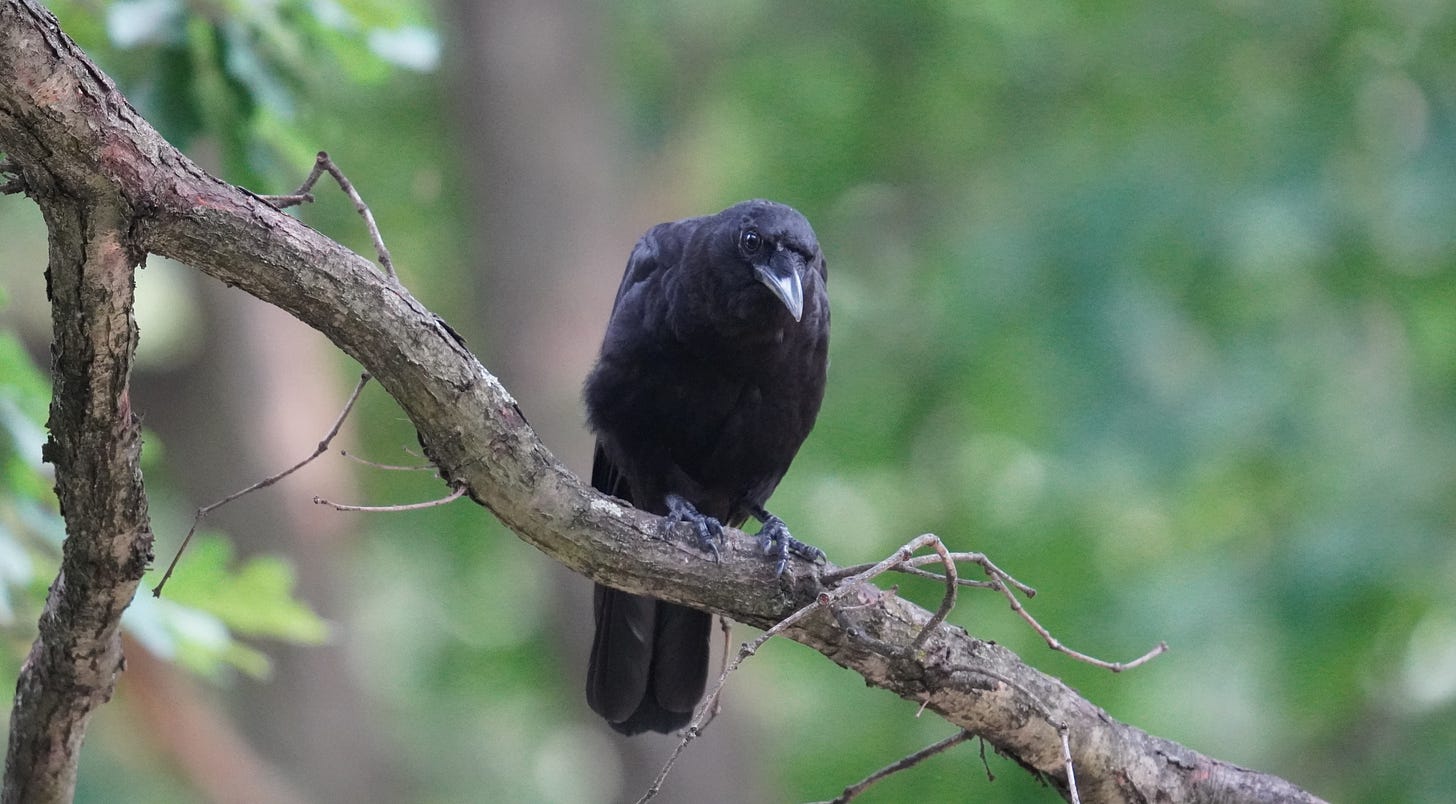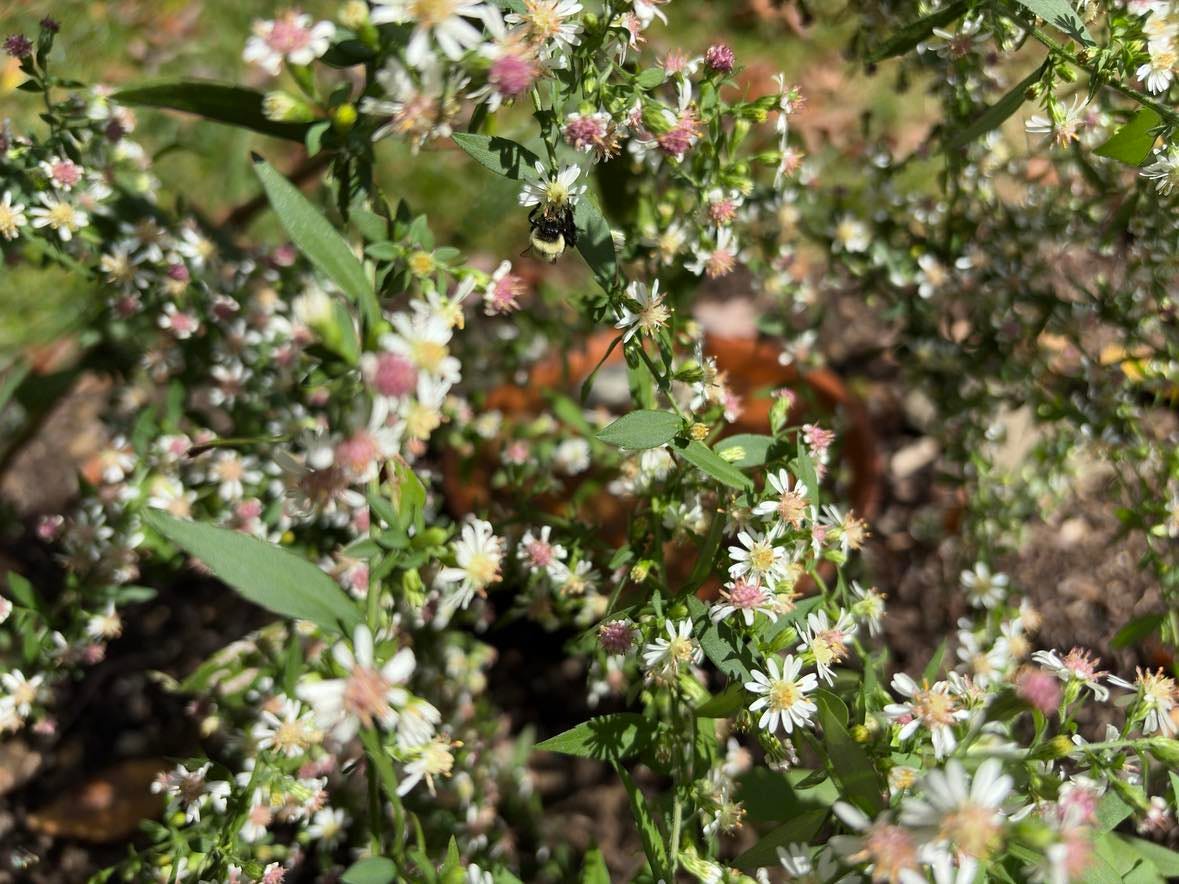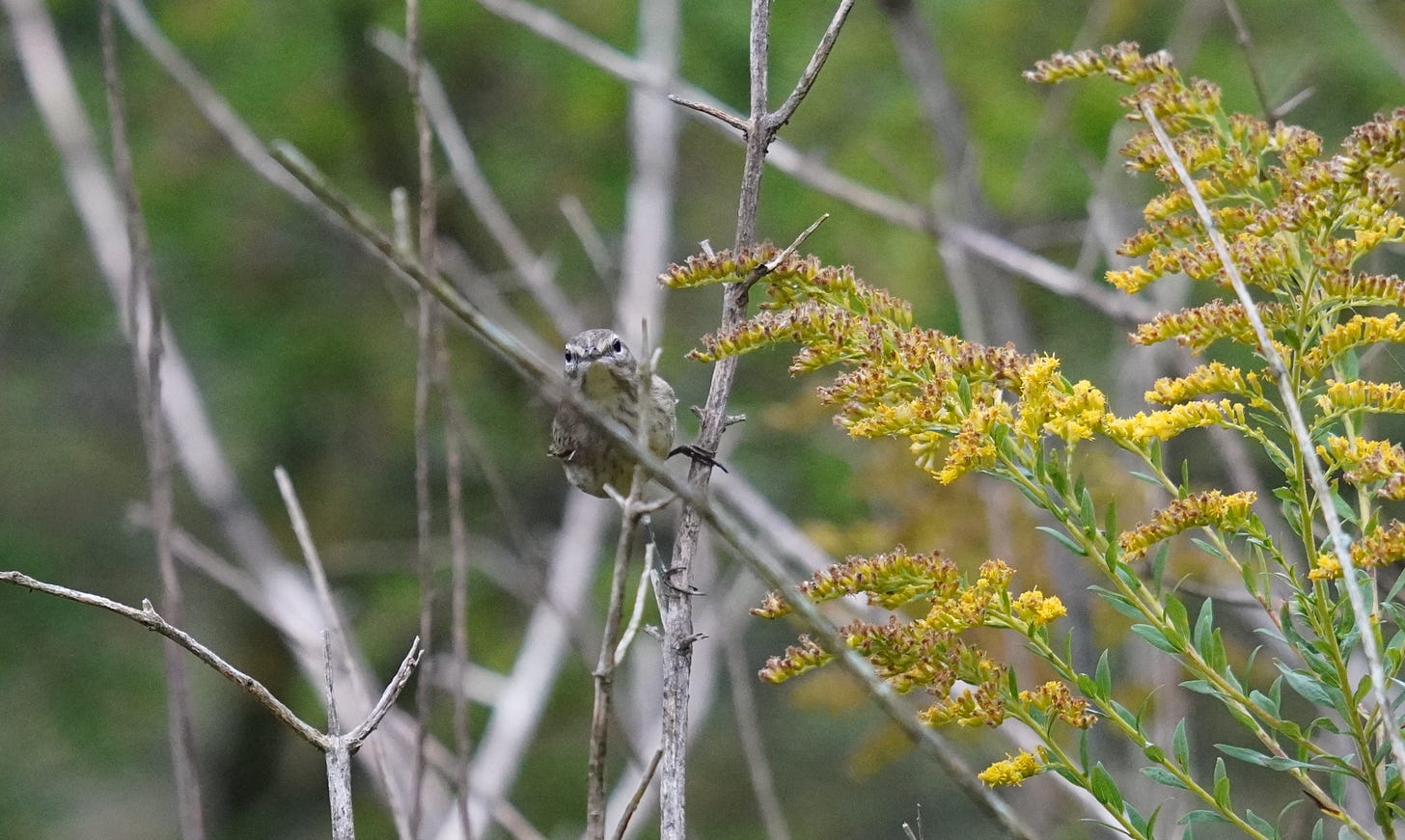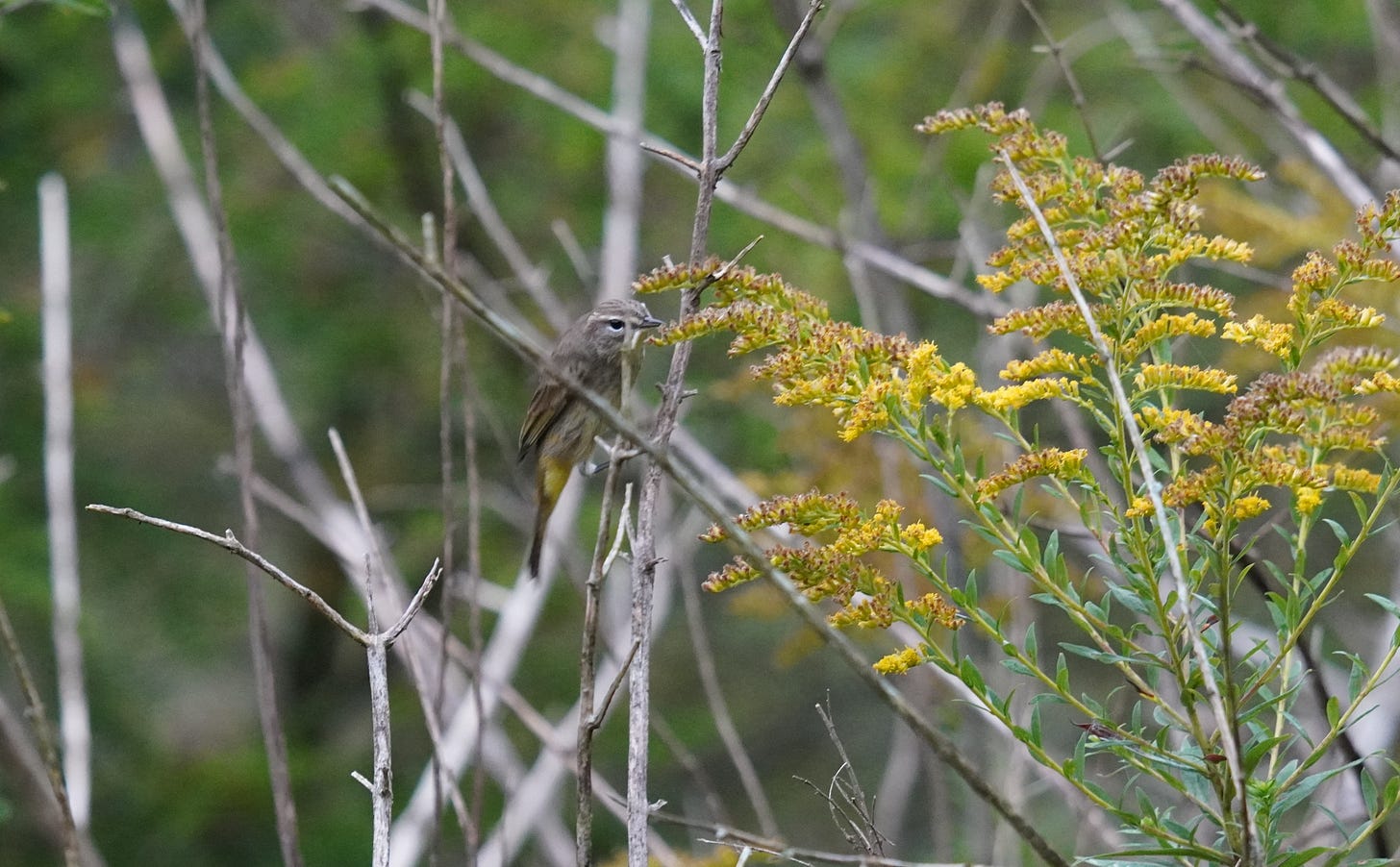Is This Good for Birds?
On Coffee, Conservation, and the Completely Rent-free Existence of Birds in My Head
I drink shit coffee. It brings me great joy every morning, but it’s not the good stuff. I buy it on sale and in bulk, and every night I load up my ancient drip coffeemaker and set the timer for 6:15. Is this garbage coffee good for birds? I sometimes ask myself. Unlikely. Not much of anything humans do is good for birds. But there are probably coffees out there that do better by the birds in the ways they’re grown, processed, packaged, shipped…
These are the things I think about these days. The birds are in my head like that. After a morning cuddle with my wife (who has a beautiful Substack about love and storytelling), I arise, drink two cups of my bad coffee, and see our boys off to school. They’re wonderful kids, but they don’t give a fig about birds. I like to think they care that I care, but so far my efforts to raise fourth-generation bird fanatics have gone nowhere fast. Still, I remain hopeful. More birders is good for birds.
By now it’s 8:00. I peel a hard-boiled egg. Not for me. I give the three American Crows who live in our woodsy Pittsburgh suburb—Dipper, Mabel, and Grunkle Stan—an egg every morning. Is this practice good for them? Maybe I should look into that. I know they like it. They eat it yolk-first, and they scream for it if I’m late. And yet they won’t come get it while I’m outside.

They still don’t trust me. Kaeli Swift explains in her ABA Podcast appearance that crows in general are slow to trust humans, even the ones who feed them. That seems wise, and no hard feelings. I lay the egg in the usual spot—a big rock in our front yard—and freshen the nearby birdbath. It has to be cleaned daily, because every day the Mourning Doves, beautiful nincompoops, defile the water with their nincompooping.
I check the feeders. Full enough. The regulars are already busily eating. Northern Cardinal, Tufted Titmouse, White-breasted Nuthatch. There’s Black-capped Chickadee too. Or maybe it’s a Carolina Chickadee. Or a hybrid Black-capped x Carolina Chickadee. We live in an overlap zone, so I’m never quite sure what species of chickadee I’m seeing. But they’re here. Tame in a way the crows are not. Is feeding birds good for them? I agonize over this question. I know not cleaning the feeders is bad for them. Ours are probably due a scrubbing.
I’m pretty sure the garden I started last spring is good for birds. I’m trying to re-native our yard, which the previous owners had decorated with an uninspired mix of non-natives. It’s a challenge. Our property is shaded by the dense foliage of giant oaks, hawthorns, and sassafrases, but when the township repaired a sewer line last year and cut down a bunch of trees (DEFINITELY NOT GOOD FOR BIRDS!), it opened a sunny crescent where the plants we’re growing can thrive. The calico aster is making a late surge for garden MVP. Its hundreds of tiny white blossoms are swarmed constantly by pollinators.
I want to transform this yard into a native paradise—full of plants that attract bugs that attract birds. It’s a selfish goal, but one I think can be beneficial to all involved.
After watering the garden, it’s time gear up—Hat ☑️ Binoculars ☑️ Cellphone ☑️ Camera ☑️ SD card ❓❓❓
It’s late September, and the sky is how I like it. Overcast, but not dark. The day is getting bright, but without glare. As the woods start to come alive with bird sounds, I get eager. Migration is still in full swing. I hear a Swainson’s Thrush in the distance making the “weeep” call I always forget about. I’ve been seeing one or two almost every day. It’s been a great fall for them here.
The thrush is my cue to pull out my phone and start an eBird checklist. In this location, at this time of year, 40 birds would put a 🙂 on my face. A list of 50 would have me all 😃 🎉 🍾
I do this every day—count the birds. I know it’s good for them. My list will go to the Cornell Lab of Ornithology, where smart, conservation-minded people will get a bit more info from my corner of the world, a small yet important drop in their quest to save birds. I’ve submitted a checklist 273 days in a row, so this drop is just one in a steady trickle.
In the woods behind the house I find the deer path that will lead me (sort of) safely down to the creek at the bottom of our steep ravine. It’s been raining. The water is higher than it’s been in weeks. I see more and larger fish schooling up and down stream. That’s good for Osprey. Herons and kingfishers too. I cross the creek and feel my shoes get waterlogged and heavy.
As soon as I reach the other side, I’m on the lookout. This is a good warbler spot. They like the little wooded hill by the creek. I’ve gotten a Mourning Warbler here three migrations in a row. I like to think I’ll get a Connecticut Warbler too, but I know I won’t. Never have. Feels like I never will. I preemptively curse it. I’m so vexed by this goddam bird, I think it’s starting to color my feelings about the state. Is cursing birds bad for them? My wife, ever obsessed with the power of words, would say yes, but I don’t think they care. Connecticut probably doesn’t give a shit either.
Locals I’ve run into have told me this area used to be heavily industrial, a dumping site where the byproducts of steel manufacturing were separated and repurposed. Very Pittsburgh, but also very bad for birds. Vestiges of infrastructure remain, however today this still-privately-owned land is overgrown with trees, shrubs, vines, and wildflowers. Good for birds. I’ve counted 136 species down here since relocating from Michigan in September 2022, Palm Warbler among them. This one I captured gleaning insects in the goldenrod. Not great photos, but then I’m not a great photographer.
There’s an Eastern Phoebe too. They’re not getting along. It’s fun to watch two different species, a warbler and a flycatcher who share the habit of constantly bobbing their tails up and down, battle it out for tail-bobbing supremacy.
It’s a nice start to a count that will reach 30 😐. Next I find a Yellow-rumped Warbler. There will be a ton of them flowing through soon. Suddenly lots of warblers appear out of nowhere. A Black-throated Green. Chestnut-sided. Northern Parula. I wish them all luck in their long journey south, and I hope wherever they winter the people there are thinking about and doing what’s good for birds.
Because birds are good for us. Taking care of them means preserving and restoring and safeguarding their natural habitats. It means making their annual paths north and south less perilous. It means decontaminating our earth, air, and water. All of that means a healthier world for all who inhabit it. That’s important for a guy like me, a guy who turns 49 today, a guy who almost certainly has more years behind him than ahead, but who also has two young sons with whole lives in front of them. I’d like the birds to be there for them, whether they choose a birder’s life or not.
Welcome to my Substack. I hope it will be good for birds. I invite you to join me, so we can do what’s good for birds together. Let me start by seeking out an eco-friendlier brand of coffee. I’ll let you know what I find in my next post. What about you? What do you do that’s good for birds? Let me know in the comments!
Oh, and I want to mention one last thing that’s very good for birds—the American Birding Association. I’ve been a member for several years. I get so much out of their content, from Birding magazine to the weekly American Birding Podcast, and I’m so aligned with their mission, that I want to give something back. Thus I commit to donating 5% of my Substack earnings to the ABA. Though much of what I produce here will remain free, I’ll be developing some paid content in the coming weeks, and I’m gratefully accepting pledges from generous and like-minded readers.
Featured Photo - Black-throated Blue Warbler
I took this photo of a Black-throated Blue Warbler at Beechwood Farms Nature Reserve in Fox Chapel, PA. The bird threw me for a minute because it’s missing its signature white wing patch, which Merlin describes as “lacking only on the dullest immature females.” That seems harsh. True she may not be as flashy as her male counterparts, but I find her to be a subtly stunning bird. Richly colored in warm olive and buff hues, and decorated with a lower eye crescent, understated mask, and an eye stripe that would give any waterthrush a run for its money. And get a load of that sickle of a rear toe on the right foot! Passerine af.
That this is easily the best series of warbler pictures I’ve ever taken is hardly a surprise. Black-throated Blues tend to hang out more at eye level than many in their family, and they seem more sluggish in their feeding and less skittish in general around people. She posed here for a good 20 seconds, giving inept me plenty of time to train my lens and get a good focus on the eye.
10/10 Recommends
The Wild Robot, written and directed by Chris Sanders
This tale of an orphaned gosling, a friendless fox, and a shipwrecked robot forming a makeshift family of misfits is storytelling at its finest. The film, packaged in beautiful animation, music, and voice acting, delivers one hell of an emotional wallop and is easily my favorite of the year. 10/10 recommend. 10/10 you will cry 🪿 🦊 🤖
Kaeli Swift, PhD
I mentioned Kaeli Swift above, one of my first follows when I was getting into bird Twitter. She’s a master of entertaining educational bird content, especially when it comes to crows. Never one to shy away from the weird or gross, these days she’s more active on Instagram and Tiktok and is the perfect spooky season follow 🐦⬛ 🎃
That’s all for now.
Until next time, bird your ass off!
nwb






I'm grateful to read your writing again, Nate - thanks! I learn a lot from you and your perspective on the world!
Your checklist of gear made me think of the opposite: what not to have in the garden/neighbourhood, ie, cats 😬 Back in the dog days, no cats dared come near our garden, but now they do, and I notice a decline in bird visitors. I mean: I like cats. But too: I love birds. We used to get so many robins and blackbirds and tits of various types.